42 start with S start with S

Federico Borromeo, Cardinal-Archbishop of Milan (1564–1631), is well known as a leading Catholic reformer and as the founder of the Ambrosiana library, art collection, and academy in that city. Less known is the fact that the institution's art museum was the culmination of many decades of reflection on the aesthetic qualities and religious roles of art. Borromeo recorded his reflections in two treatises.
De pictura sacra (Sacred Painting, 1624) laid out the rules that artists should follow when creating religious art. Borromeo touched on dozens of iconographical issues and in so doing drew on his deep knowledge not only of church fathers, councils, and scripture but also of classical art and literature. In Musaeum (1625) Borromeo showed a less doctrinaire and more personal side by walking the reader through the Ambrosiana and commenting on specific works in his collection. He offered some of the earliest and most important critiques to survive on works by artists such as Leonardo, Titian, and Jan Brueghel the Elder.
This volume offers, for the first time, translations of the treatises directly into English as well as freshly edited Latin texts, an introduction, extensive notes, and an appendix on the Academy of Design that was established in conjunction with the museum. These treatises will be of great interest to students of the history of art, museums, and religion.
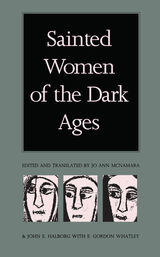
Three of these holy women were queens who turned to religion only after a period of intense worldly activity. Others were members of the Carolingian family, deeply implicated in the political ambitions of their male relatives. Some were partners in the great Irish missions to the pagan countryside and others worked for the physical salvation of the poor. From the peril and suffering of their lives they shaped themselves as paragons of power and achievement. Beloved by their sisters and communities for their spiritual gifts, they ultimately brought forth a new model of sanctity.
These biographies are unusually authentic. At least two were written by women who knew their subjects, while others reflect the direct testimony of sisters within the cloister walls. Each biography is accompanied by an introduction and notes that clarify its historical context. This volume will be an excellent source for students and scholars of women's studies and early medieval social, religious, and political history.

A collection of medieval tales of Byzantine saints, including some rejected by the Church, translated into English for the first time.
The legends collected in Saints at the Limits, despite sometimes being viewed with suspicion by the Church, fascinated Christians during the Middle Ages—as related cults, multiple retellings, and contemporary translations attest. Their protagonists span the entire spectrum of Byzantine society, including foreigners, soldiers, ascetics, lustful women, beggars, and the sons and daughters of rulers. They travel to exotic lands, perform outlandish miracles, suffer extraordinary violence, reject family ties, save cities, destroy absolute rulers, and discover the divine. Some saints, like Markos the Athenian, are forgotten nowadays; others, like Saint George the Great Martyr, still command a wide appeal. Each, however, negotiates the limits of Byzantine imagination: the borders that separate the powerful from the outcasts, the real from the imaginary, the human from the beyond human. These stories, edited in Greek and translated into English here for the first time, continue to resonate with readers seeking to understand universal human fears and desires in their Byzantine guise.

Saints of Ninth- and Tenth-Century Greece collects funeral orations, encomia, and narrative hagiography. Together, these works illuminate one of the most obscure periods of Greek history—when holy men played central roles as the Byzantine administration reimposed control on southern and central Greece in the wake of Avar, Slavic, and Arab attacks and the collapse of the late Roman Empire. The bishops of the region provided much-needed leadership and institutional stability, while ascetics established hermitages and faced invaders. The Lives gathered here include accounts of Peter of Argos, which offers insight into episcopal authority in medieval Greece, and Theodore of Kythera, an important source for the history of piracy in the Aegean Sea.
This volume, which illustrates the literary variety of saints’ Lives, presents Byzantine Greek texts written by locals in the provinces and translated here into English for the first time.
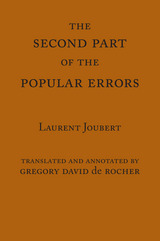
English translation of the second volume of Laurent Joubert’s 1578 French work Erreurs Populaires
Joubert proposed to dispel folk remedies and folklore still relied on by doctors and care-givers in France. It also challenged medical theories and advice from classical Greek and Latin writers that French doctors followed uncritically.
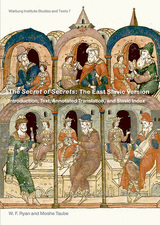
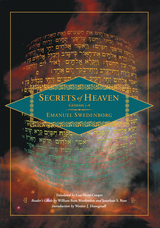
The first major theological work of the Swedish scientist-turned-seer Emanuel Swedenborg, Secrets of Heaven is in one sense a traveler's account. It reveals the unseen realms that await beyond death--the light, the warmth, and harmony of the angelic heavens and the varied darkness of the multitudinous hells. But in addition, the work offers a detailed examination of Genesis and Exodus, providing a model for a new way to understand the entire Bible. Prized for both the simplicity of its explanation and the breadth and depth of its vision, Swedenborg's reading of Scripture discloses layer upon layer of inner meaning, all without undermining the power and import of the literal word.
This first of the multivolume work contains an introduction by Wouter J. Hanegraaff, professor of History of Hermetic Philosophy and Related Currents at the University of Amsterdam, and a reader's guide by Swedenborgian scholar William Ross Woofenden and New Century Edition Series Editor Jonathan S. Rose.
The New Century Edition of the Works of Emanuel Swedenborg is a modern-language, scholarly translation of Swedenborg’s theological works. The series’ easy-to-read style retains the dignity, variety, clarity, and gender-inclusive language of Swedenborg’s original Latin, bringing his thought to life. Introductions and annotations by eminent, international scholars place Swedenborg’s writings in their historical context and illuminate obscure references within the text, enabling readers to understand and trace Swedenborg’s influence as never before.
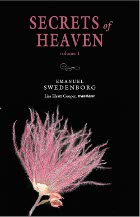
The first major theological work of the Swedish scientist-turned-seer Emanuel Swedenborg, Secrets of Heaven is in one sense a traveler's account. It reveals the unseen realms that await beyond death--the light, the warmth, and harmony of the angelic heavens and the varied darkness of the multitudinous hells. But in addition, the work offers a detailed examination of Genesis and Exodus, providing a model for a new way to understand the entire Bible. Prized for both the simplicity of its explanation and the breadth and depth of its vision, Swedenborg's reading of Scripture discloses layer upon layer of inner meaning, all without undermining the power and import of the literal word.
The New Century Edition of the Works of Emanuel Swedenborg is a modern-language, scholarly translation of Swedenborg’s theological works. The series’ easy-to-read style retains the dignity, variety, clarity, and gender-inclusive language of Swedenborg’s original Latin, bringing his thought to life.
This portable edition of Secrets of Heaven vol. 1 includes the text of the New Century Edition without the introduction, annotations, and other supplementary of the deluxe hardcover and paperback editions.
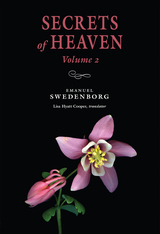
Secrets of Heaven is Emanuel Swedenborg’s magnum opus, a fifteen-volume work that delves into the inner, spiritual meaning of the Bible. Starting from the first verse, Swedenborg goes through Genesis and Exodus verse by verse, sometimes word by word, uncovering the fascinating teachings behind the literal account. By doing careful comparison of passages and tracing individual images and motifs through the Bible, he demonstrates that it contains a profound, coherent, and unified inner meaning.
The second volume covers Genesis 9–15, beginning with God’s covenant with Noah following the Flood and then following the familiar story of the patriarch Abraham. In the process, Swedenborg discusses the concept of regeneration, or spiritual rebirth, and describes the way the people act before and after rebirth. He also talks about an epoch of human history that he calls the ancient church and the spiritual state of the people in that church. Interspersed with the biblical commentary are chapters on related topics such as the lives of angels in heaven, how distance and time work in the spiritual world, and the nature of hell.
Secrets of Heaven provides essential insight into Swedenborg’s theology and lays the groundwork for the rest of his writings. This new translation, part of the New Century Edition series, makes his insights into Scripture and his accounts of his spiritual experiences more accessible than ever before.
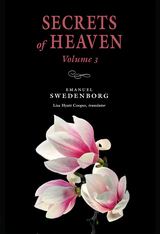
This third volume covers the inner meaning of Genesis 16–21, giving an account of the early stages of Jesus’ inward development, including the interactions of his human side and his divine side. It additionally addresses other topics, and in particular the true nature of the Last Judgment.
This new translation, part of the New Century Edition series, makes Swedenborg’s insights into Scripture and his accounts of his spiritual experiences more accessible than ever before.
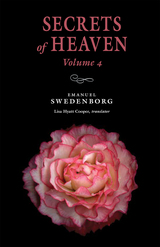
This fourth volume covers the inner meaning of Genesis 22–26, which on the surface recount God’s testing of Abraham and the generational shift that occurs as Sarah and Abraham die, Isaac and Rebekah marry, and Jacob and Esau are born. The intricacies of this narrative are interpreted as the processes Jesus went through inwardly as he united his human and divine natures and established a new religious culture on earth. Much of this volume also explores the concepts of correspondence and representation as underlying realities present in the natural and spiritual worlds and in the Bible.
This new translation, part of the New Century Edition series, makes Swedenborg’s insights into Scripture and his accounts of his spiritual experiences more accessible than ever before.
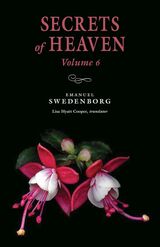
Secrets of Heaven is Emanuel Swedenborg’s magnum opus, a fifteen-volume work that delves into the inner, spiritual meaning of the Bible. Starting from the first verse, Swedenborg goes through Genesis and Exodus verse by verse, sometimes word by word, uncovering the fascinating teachings behind the literal account. By engaging in a careful comparison of passages and tracing individual images and motifs through the Bible, he shows that it contains a profound, coherent, and unified inner meaning.
This sixth volume interprets the inner narrative of Genesis 31–35, in which Jacob leaves Laban’s house, wrestles with God, and reunites with Esau. These acts, Swedenborg argues, are each symbolic of the inner separations, struggles, and unifications that Jesus accomplished on his path to divinity. Swedenborg continues to explore two themes found in previous volumes: the Last Judgment as the ending of an old church and the beginning of a new church, and the correlation between human individuals and the “universal human.”
This new translation, part of the New Century Edition series, makes Swedenborg’s insights into Scripture and his accounts of his spiritual experiences more accessible than ever before.
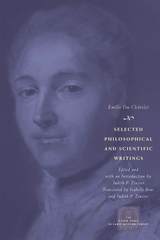
Though most historians remember her as the mistress of Voltaire, Emilie Du Châtelet (1706–49) was an accomplished writer in her own right, who published multiple editions of her scientific writings during her lifetime, as well as a translation of Newton’s Principia Mathematica that is still the standard edition of that work in French. Had she been a man, her reputation as a member of the eighteenth-century French intellectual elite would have been assured.
In the 1970s, feminist historians of science began the slow work of recovering Du Châtelet’s writings and her contributions to history and philosophy. For this edition, Judith P. Zinsser has selected key sections from Du Châtelet’s published and unpublished works, as well as related correspondence, part of her little-known critique of the Old and New Testaments, and a treatise on happiness that is a refreshingly uncensored piece of autobiography—making all of them available for the first time in English. The resulting volume will recover Châtelet’s place in the pantheon of French letters and culture.
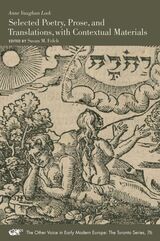
This volume provides a collection of Lock’s works presented in modern spelling, and it includes additional contemporary materials that place her voice in the larger context of the Tudor period, offering insight into the intertwined complexities of political, social, and religious life in sixteenth-century England.
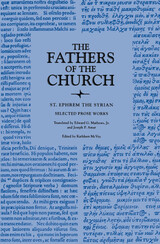
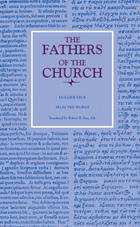
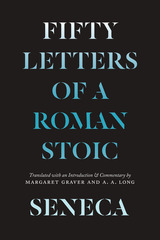
“There is only one course of action that can make you happy. . . . rejoice in what is yours. What is it that is yours? Yourself; the best part of you.”
In the year 62, citing health issues, the Roman philosopher Seneca withdrew from public service and devoted his time to writing. His letters from this period offer a window onto his experience as a landowner, a traveler, and a man coping with the onset of old age. They share his ideas on everything from the treatment of enslaved people to the perils of seafaring, and they provide lucid explanations for many key points of Stoic philosophy.
This selection of fifty letters brings out the essentials of Seneca’s thought, with much that speaks directly to the modern reader. Above all, they explore the inner life of the individual who proceeds through philosophical inquiry from a state of emotional turmoil to true friendship, self-determination, and personal excellence.
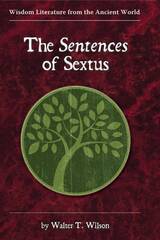
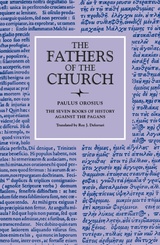
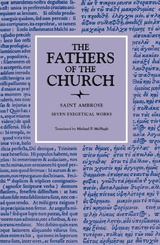

Antiquity’s original didactic poet.
Hesiod describes himself as a Boeotian shepherd who heard the Muses call upon him to sing about the gods. His exact dates are unknown, but he has often been considered a younger contemporary of Homer.
The first volume of this revised Loeb Classical Library edition offers Hesiod’s two extant poems and a generous selection of testimonia regarding his life, works, and reception. In Theogony, Hesiod charts the history of the divine world, narrating the origin of the universe and the rise of the gods, from first beginnings to the triumph of Zeus, and reporting on the progeny of Zeus and of goddesses in union with mortal men. In Works and Days, Hesiod shifts his attention to humanity, delivering moral precepts and practical advice regarding agriculture, navigation, and many other matters; along the way he gives us the myths of Pandora and of the Golden, Silver, and other Races of Men.
The second volume contains The Shield and extant fragments of other poems, including the Catalogue of Women, that were attributed to Hesiod in antiquity. The former provides a Hesiodic counterpoint to the shield of Achilles in the Iliad; the latter presents several legendary episodes organized according to the genealogy of their heroes’ mortal mothers. None of these is now thought to be by Hesiod himself, but all have considerable literary and historical interest.
Glenn W. Most has thoroughly revised his edition to take account of the textual and interpretive scholarship that has appeared since its initial publication.
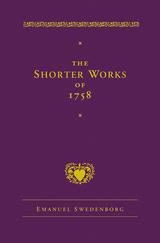
This volume contains four shorter works by the influential eighteenth-century mystic Emanuel Swedenborg. Translators George F. Dole and Jonathan S. Rose have produced an accessible rendering of these important yet easily overlooked works.
New Jerusalem: In this work Swedenborg outlines his theology in twenty-three brief chapters on major Christian topics such as love, faith, regeneration, the inner self and outer self, and the nature of the Bible. Nearly every chapter ends with what is in effect an index to that topic as it appears in his much larger study Secrets of Heaven.
Last Judgment: This work on the “end times” asserts that the Last Judgment foretold in the Bible does not involve the end of the physical world. Rather, the Last Judgment was an event of tremendous upheaval in the spiritual world, a nonmaterial apocalypse which has already occurred and which Swedenborg himself witnessed.
White Horse: This brief work is divided into two parts. The first presents the inner meaning of the white horse mentioned in chapter 19 of the book of Revelation. The second is effectively an index to passages concerning the Bible and its inner meaning in Swedenborg’s much larger work Secrets of Heaven. This work is a good short introduction to Swedenborg’s principle of correspondences between the spiritual and physical worlds, as well as to his unique view of the nature of the Bible.
Other Planets: Building on the eighteenth-century fascination with the possibility of life on other worlds and with traveler’s tales of other cultures, this work describes life on other planets in our solar system and elsewhere in the universe. Swedenborg undertook this work specifically to demonstrate that Jesus is God not just of planet Earth but also of the universe as a whole.
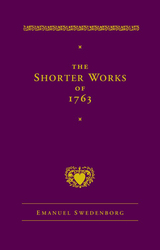
The four main short works in this volume by Swedish theologian Emanuel Swedenborg (1688–1772) form the basic foundation of his thought. Although originally printed as if they were stand-alone volumes, they have nearly always been published together, generally under the collective title “The Four Doctrines.”
The Lord discusses the nature of the man known as Jesus Christ, his divine nature, and the meaning of his crucifixion. For Swedenborg, Jesus was not simply a man, but the eternal divine that came to earth for the salvation of humanity.
Sacred Scripture is about the Word, by which Swedenborg means the parts of the Bible that he feels reflect a deep spiritual teaching. Swedenborg believes that study of the Word—which contains a wisdom that predates the written Bible and also transcends it—is the key to humanity’s spiritual development and its eventual union with the Lord.
Life discusses the nature of good and evil and the necessity of shunning sin and evil in order to experience true faith and become a spiritual person. In other words, this work is about how we ought to live.
Faith talks about faith as an acknowledgment of inner truth and the necessity of expressing such faith through good actions rather than simply holding beliefs. Swedenborg also delves into the true nature of charity and the way that it interweaves with faith to produce true goodness.
In addition to these short works, the volume includes a fifth work, which consists of two supplements to previous works by Swedenborg: a brief addition to Last Judgment and a longer addition to Heaven and Hell.
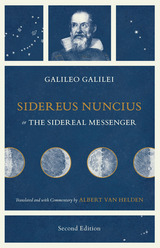
Albert Van Helden’s beautifully rendered and eminently readable translation is based on the Venice 1610 edition’s original Latin text. An introduction, conclusion, and copious notes place the book in its historical and intellectual context, and a new preface, written by Van Helden, highlights recent discoveries in the field, including the detection of a forged copy of Sidereus Nuncius, and new understandings about the political complexities of Galileo’s work.
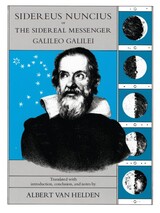
"[Sidereus nunclus] has never before been made available in its entirety in a continuous form, with full notes and comment. The introduction, translation and notes by Van Helden are a splendid example of the best scholarship and fullest accessibility. . . . we can now truly get to grips with the phenomenon of Galileo and what his life and work should mean to us today."—Robert Temple, Nature


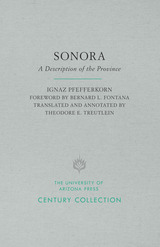
"To be read for enjoyment; nevertheless, the historian will find in it a wealth of information that has been shrewdly appraised, carefully sifted, and creditably related."—Catholic Historical Review
"Of interest not only to the historian but to the geographer and anthropologist."—Pacific Historical Review
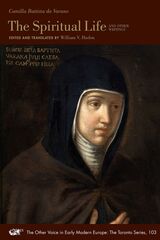
Camilla Battista da Varano (1458–1524) was a Franciscan nun and the author of profound spiritual writings in both prose and verse. Raised in the princely household of Camerino in north-central Italy, she put her thorough humanist education to use explaining her own spiritual experience and delivering advice to others. Varano composed ecstatic revelations, prayers, poems, hagiography, spiritual direction, and commentary on convent legislation. She drew on a wide variety of sources, including scripture and Church Fathers, plus popular literature and proverbs. Varano was an erudite woman of considerable complexity, defying many of the commonplace images we associate with religious women of the late fifteenth and early sixteenth centuries.
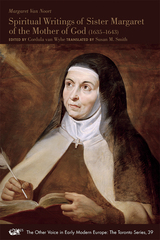
In 1635, as directed by her confessor so that he might understand “the state of her soul,” Margaret Van Noort, a lay sister of the royal convent of Discalced Carmelite nuns in Brussels, composed her spiritual autobiography. This text was followed by two diaries in 1636 and 1637 recording the workings of her inner life and relation to God, and reflecting the cosmopolitan Catholic tradition of her homeland. Now gathered in this volume, these works illustrate Margaret’s development from a troubled young lay sister into a woman of spiritual experience and authority.
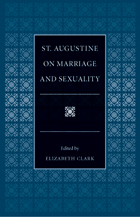
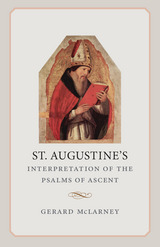
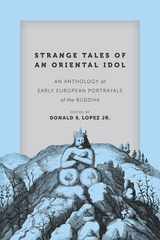
Featuring writings by soldiers, adventurers, merchants, missionaries, theologians, and colonial officers, this volume contains a wide range of portraits of the Buddha. The descriptions are rarely flattering, as all manner of reports—some accurate, some inaccurate, and some garbled—came to circulate among European savants and eccentrics, many of whom were famous in their day but are long forgotten in ours. Taken together, these accounts present a fascinating picture, not only of the Buddha as he was understood and misunderstood for centuries, but also of his portrayers.

Ancient expertise on water and warfare.
Frontinus, Sextus Iulius, ca. AD 35–103, was a capable Roman civil officer and military commander. Praetor of the city in 70 and consul in 73 or 74, 98 and 100, he was, about the year 76, sent to Britain as governor. He quelled the Silures of Wales, and began to build a road through their territory; his place was taken by Agricola in 78. In 97 he was given the highly esteemed office of Manager of Aqueducts at Rome. He is known to have been an augur, being succeeded by his friend Pliny the Younger.
The two sides of Frontinus’ public career are reflected in his two surviving works. Stratagems, written after 84, gives examples of military stratagems from Greek and Roman history, for the instruction of Roman officers, in three books; the fourth book is concerned largely with military discipline. The Aqueducts of Rome, written in 97–98, gives some historical details and a description of the aqueducts for the water supply of the city, with laws relating to them. Frontinus aimed at being useful and writes in a rather popular style which is both simple and clear.
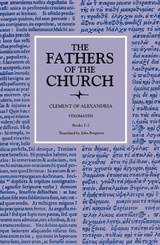
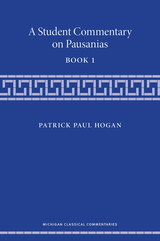
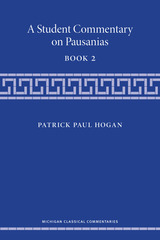
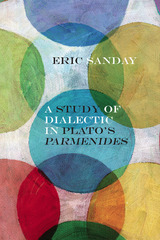
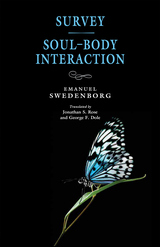
These two shorter works by Swedish theologian Emanuel Swedenborg (1688–1772), originally published separately and very different in content, both represent Swedenborg’s own effort to summarize complex areas of his thought.
Published toward the end of Swedenborg’s life, Survey of Teachings of the New Church was a forerunner to his final theological work, True Christianity. In Survey, Swedenborg discusses some key tenets of Christian doctrine, both Catholic and Protestant, and describes how his own theology differs from it. He focuses on key concepts such as the Trinity, the nature of faith and charity, and the spiritual nature of the Last Judgment described in the book of Revelation. Taken as a whole, the piece is a brief summation of the doctrines that Swedenborg felt were critical for the coming spiritual age.
Soul-Body Interaction addresses a crucial area of Swedenborg’s thought: the way that life flows from the transcendent God into all living things. Swedenborg describes the nature and structure of the spiritual world, including heaven, hell, and the intermediate world of spirits, and describes how the higher levels of being reflect a more perfect conjunction with God. He also traces the flow of the Lord’s love and wisdom into the soul of all living people, showing how it gives life regardless of their current spiritual state.
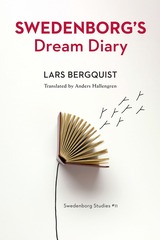
Swedish man of letters Lars Bergquist explains the often enigmatic but always fascinating dream journal kept by Emanuel Swedenborg from 1743 to 1744. A scientist, Swedenborg meticulously recorded his dreams and visions, adding interpretations that foreshadowed modern dream analysis. After an Easter vision in 1745, Swedenborg abandoned his scientific studies and dedicated his life to studying the inner meaning of Sacred Scripture. In his diary, he reveals his daily life and the reflections that are a key to understanding his later spiritual works.
"The book enables us to follow Swedenborg...from dismal gloom to inner splendor."
--Gunnar Bronerg, Upsala Nya Tidning
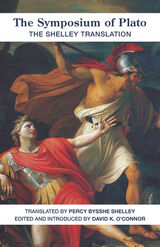

READERS
Browse our collection.
PUBLISHERS
See BiblioVault's publisher services.
STUDENT SERVICES
Files for college accessibility offices.
UChicago Accessibility Resources
home | accessibility | search | about | contact us
BiblioVault ® 2001 - 2024
The University of Chicago Press









